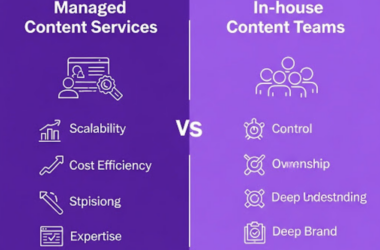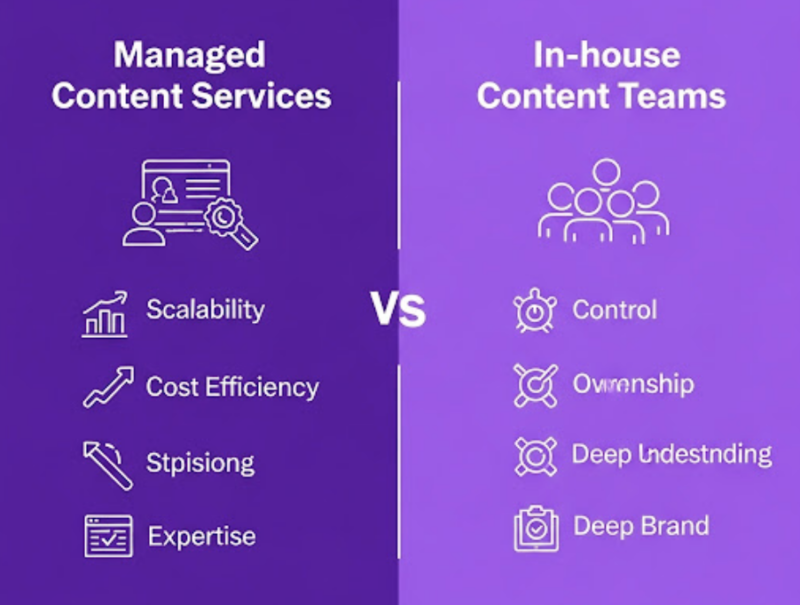“Content Marketing is all the Marketing that’s left.” —Seth Godin
As content becomes one of the most powerful drivers of brand visibility and growth, businesses are focusing on scaling their efforts more efficiently and effectively.
Amid growing investment in content marketing to meet rising demands for personalization, choosing between an in-house content team and a managed content service is more crucial than ever.
An in-house team offers close collaboration and strong brand alignment. At the same time, a managed content service is an external partner that delivers scalable, end-to-end content support with broader expertise and quicker turnaround.
In this post, we explore both models, their pros, cons, and trends, plus other key factors to guide your decision. Let’s start!
Table of Contents
- Understanding the Two Content Models
- Advantages and Challenges of In-house Content Teams
- Advantages and Potential Drawbacks of Managed Content Services
- Cost Considerations and Return on Investment (ROI)
- Align Your Content Strategy with Business Goals for Maximum Impact
- FAQs
Understanding the Two Content Models
Studies show that short articles and videos are the most commonly used content formats among B2B marketers. Additionally, a large number of both B2B and B2C marketers regularly analyze content performance to drive growth.
Before choosing a content strategy, it’s essential to understand the structure and strengths of both in-house teams and managed content services. Each model serves different business needs, from brand alignment to scalability.
In-house content teams
- Integrated inside your company: Full-time employees of your company with writing, editing, content strategy, and, sometimes, SEO specialties.
- More in line with the brand: You get a thorough grasp of your brand’s voice, values, and objectives through consistent exposure and cooperation with a content producer
- Interdepartmental cooperation: It is easier to make sure that the current status of other goals and initiatives is appropriately reflected when senior management, marketing, and product teams collaborate.
- Faster and more flexible feedback: Another benefit of creating content internally is that it allows for instant communication and iteration, which is essential for things like product launches and campaign modifications.
Ideal for: Brands that develop inter-departmental collaboration, trying to concentrate on longer-term strategic courses, wherein the whole brand’s ecosystem is deeply immersed.
Managed content services
- Complete third-party solution: Assign all contracted work to a different platform or agency, including content production, editing, SEO, and publication.
- Adaptable and expandable: It creates a framework that makes it possible to swiftly ramp up or down content. Without the necessity for internal hiring or training, it relies on the demands of the company.
- Acquisition of certain skills: Gain access to a global array of handpicked writers, editors, and business experts seasoned in a variety of subjects and formats.
- Slated for effective large-scale delivery: Nestled within well-established editorial, project management, and workflow processes that guarantee quality results with faster turnaround times.
Ideal for: Small marketing teams that require an experienced content partner, rapidly growing startups, or global companies requiring subject matter expertise, multilingual support, or large volumes of outsourced content writing.
| Did you know? Companies that outsource content creation can save up to 62% on content campaign costs. This shows how outsourcing can be a highly cost-effective way to scale content without compromising quality. |
Advantages and Challenges of In-house Content Teams
In-house content benefits go beyond just brand familiarity. With a dedicated internal team, businesses gain full control over content strategy, tone, and execution.
Here’s a table showcasing the key advantages and challenges to consider when evaluating an in-house content model:
| Advantages | Description | Challenges | Description |
| Deep brand understanding | In-house teams gain a nuanced and intuitive understanding of your brand’s voice, values, audience, and messaging through daily exposure. | Higher operational costs | In-house teams require a significant fixed expenditure for hiring, onboarding, payroll, benefits, software, and training, particularly for startups with limited budgets. |
| Seamless cross-functional collaboration | Product, sales, marketing, and leadership teams may readily work with internal teams to synchronize messages and collect insights. This enhances responsiveness and precision. | Scalability limitations | Increasing the team size is frequently necessary to scale up content production. Agility may be slowed during periods of high demand since hiring, training, and managing more staff require time and resources. |
| Greater control | You tend to have direct access to your team, which enables continuous quality assurance, in-the-moment editing, and impromptu ideation. This reduces turnaround times and ensures quicker alignment with business changes. | Limited access to specialized skills | Since your internal team can lack specialists in areas like technical writing, data storytelling, video scripting, or multilingual content, you are limited in the kinds of material you can produce. |
| Strategic long-term alignment | Since internal teams have insight into company-wide campaigns and objectives, they can efficiently prepare content and actively contribute to brand positioning and storytelling. | Risk of creative stagnation | Without access to outside perspectives, internal teams may produce specialized or repeated content. Lack of exposure to new concepts or market trends may hinder innovation. |
| Pro Tip: Are you wondering how to boost the impact of your content without going over budget? Utilize online tools like Canva to create captivating images that enhance your message, Surfer SEO for content optimization, and Grammarly for precise writing. |
Advantages and Potential Drawbacks of Managed Content Services
Managed content services provide flexibility, speed, and access to specialized talent, making them a smart choice for efficiently scaling content. However, they may require extra effort to align with your brand voice.
Here’s a table showcasing the core advantages and potential drawbacks to keep in mind when considering managed content marketing solutions:
| Advantages | Description | Potential drawbacks | Description |
| Cost efficiency | Outsourcing reduces the overhead of hiring, onboarding, and training full-time employees. You pay only for what you need, often at a fraction of the cost of a full in-house team. | Brand alignment challenges | External teams may not fully capture your tone or messaging without thorough onboarding, leading to content that feels generic or off-brand. |
| Access to specialized talent | Managed services provide access to a global network of successful writers, editors, strategists, and subject matter experts from a variety of formats and sectors. | Gaps in communication | Working across time zones or with remote teams may lead to intermittent misunderstandings, slower iterations, and delayed feedback. |
| Flexibility and scalability | You may simply scale up or down in response to campaign goals, seasonal demand, or changing content requirements without hiring extra employees. | Less real-time collaboration | Content approvals and modifications could take longer than with an internal team if other departments can’t be swiftly looped in. |
| Streamlined workflows | Most services offer structured processes, project management tools, and editorial oversight, ensuring timely, consistent delivery. | Limited strategic integration | Managed services often work at a tactical level. Without strategic alignment, content may lack cohesion with broader brand or business goals. |
Cost Considerations and Return on Investment (ROI)
Understanding the cost implications and potential return on investment (ROI) of each model is essential for building a sustainable and performance-driven content strategy.
In-house content teams: High investment, long-term value
Establishing an internal team entails high initial and ongoing expenses. These could consist of:
- Pay and perks for content managers, writers, editors, designers, and SEO experts
- The cost of hiring and onboarding competent personnel
- Providing training and development to keep your team up to date on tools and trends
- Subscriptions to design resources, SEO software, CMS platforms, and content tools
- Additional overhead expenses for things like equipment, office space, human resources, and IT support
In-house teams can produce a significant long-term return on investment, despite increased costs, particularly when collaboration, brand management, and strategy consistency are crucial. These teams frequently create content that reflects long-term planning and brand narrative, and they are closely tied to internal business goals.
Managed content services: Cost-effective and scalable
Managed content services offer flexible pricing structures. These may be based on project size, word count, deliverables, or monthly retainers.
Typical cost factors include:
- Fees for content creation based on quantity or complexity
- Subscription or access costs for using content platforms or SaaS tools
- Optional charges for content strategy, editing, or performance optimization
- Add-on services such as SEO services, visual design, or distribution support
Since managed services do not require full-time employees, office supplies, or internal supervision, they are typically more affordable.
From a return on investment (ROI) standpoint, these services enable businesses to access new audiences, scale content production, and react to campaign requirements faster. They are therefore the perfect option for small teams, rapidly expanding brands, and companies with varying or seasonal content needs.
Choosing based on budget and goals
Below is a quick reference table to help you evaluate which approach best suits your needs:
| Scenario | Best fit |
| You have a limited budget but need high-volume, SEO-friendly content | Managed content services |
| You prioritize brand tone, internal knowledge, and content strategy alignment | In-house content team |
| You want predictable monthly costs and more control over content operations | In-house content team |
| You need to ramp content production up or down based on campaigns | Managed content services |
| You are experimenting with new markets, products, or content types | Managed content services |
Align Your Content Strategy with Business Goals for Maximum Impact
There is no one-size-fits-all solution when choosing between a managed content provider and an internal content team.
Whether it’s the scalability, flexibility, and cost-effectiveness of outsourcing or the strategic focus and deep brand integration of an inside team, each approach has advantages.
Looking to optimize your content strategy? Wittypen delivers high-quality, tailored content creation services designed to meet your unique business goals and drive impactful marketing results.
Get in touch with us for more details!
FAQs
1. How can I maintain brand consistency with managed content services?
Share a clear style guide, brand voice doc, and examples upfront. Most services allow you to work with dedicated writers or editors, and regular feedback loops help refine quality over time.
2. What unstated expenses are associated with internal content teams?
Expect expenses for hiring, onboarding, software tools, training, and management time in addition to compensation. These can easily mount up, particularly for smaller groups.
3. At what point should I think about using a mixed content model?
If you require scalable output from a partner plus brand-focused content from your team, utilize a hybrid strategy. It’s perfect for finding a balance between suppleness and control.









